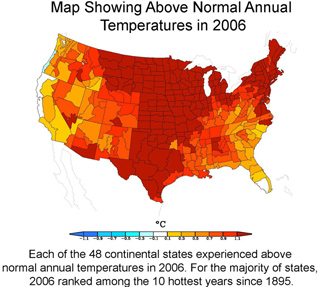Greenhouse gases made 2006 2nd-warmest year on record for U.S.
Greenhouse gases made 2006 2nd-warmest year on record for U.S.
mongabay.com
August 28, 2007
Greenhouse gases likely accounted for over half of the widespread warmth across the continental United States in 2006, report scientists writing in the September 5th issue of the journal Geophysical Research Letters.
The research team, led by Paul Hoerling at the National Oceanic and Atmospheric Administration (NOAA) Earth System Research Lab in Boulder, Colorado, found that el Niño played little role in last year’s average temperature, which was the second highest since recordkeeping began in 1895, but that other natural factors likely contributed to the near-record warmth.
“We wanted to find out whether it was pure coincidence that the two warmest years on record both coincided with El Niño events,” Hoerling said. “We decided to quantify the impact of El Niño and compare it to the human influence on temperatures through greenhouse gases.”
The scientists found that “found that greenhouse gas increases in Earth’s atmosphere enhanced the probability of U.S. temperatures breaking a record in 2006 by approximately 15-fold compared to pre-industrial times.” They say there is a 16 percent chance that 2007 will bring “record-breaking warmth”.

Map showing above normal annual temperatures in 2006. Courtesy of NOAA. |
Hoerling and colleagues examined the impact of 10 El Niño events since 1965 on average annual U.S. surface temperatures. They found the weather anomaly is associated with slight cooling across the country.
The researchers then analyzed 42 simulations of Earth’s climate from 18 climate models provided for the latest assessment by the Intergovernmental Panel on Climate Change to “assess the role of greenhouse gases in the 2006 warmth.” They found that “greenhouse gases produced warmth over the entire United States in the model projections, much like the warming pattern that was observed last year across the country.”
In reaching their conclusion, Hoerling and colleagues “compared the observed 2006 pattern of abnormal surface temperatures to the projected
effects of greenhouse-gas warming and El Niño temperature responses,” according to a statement from the American Geophysical Union. “The U.S. temperature pattern of widespread warming was completely inconsistent with the pattern expected from El Niño, but it closely matched the expected effects of greenhouse warming.”
“That attribution was not confirmed at the time,” said Hoerling. “Now we have the capability, on the spatial scale of the United States, to better distinguish natural climate variations from climate changes caused by humans.”
This article is based on a news release from the American Geophysical Union